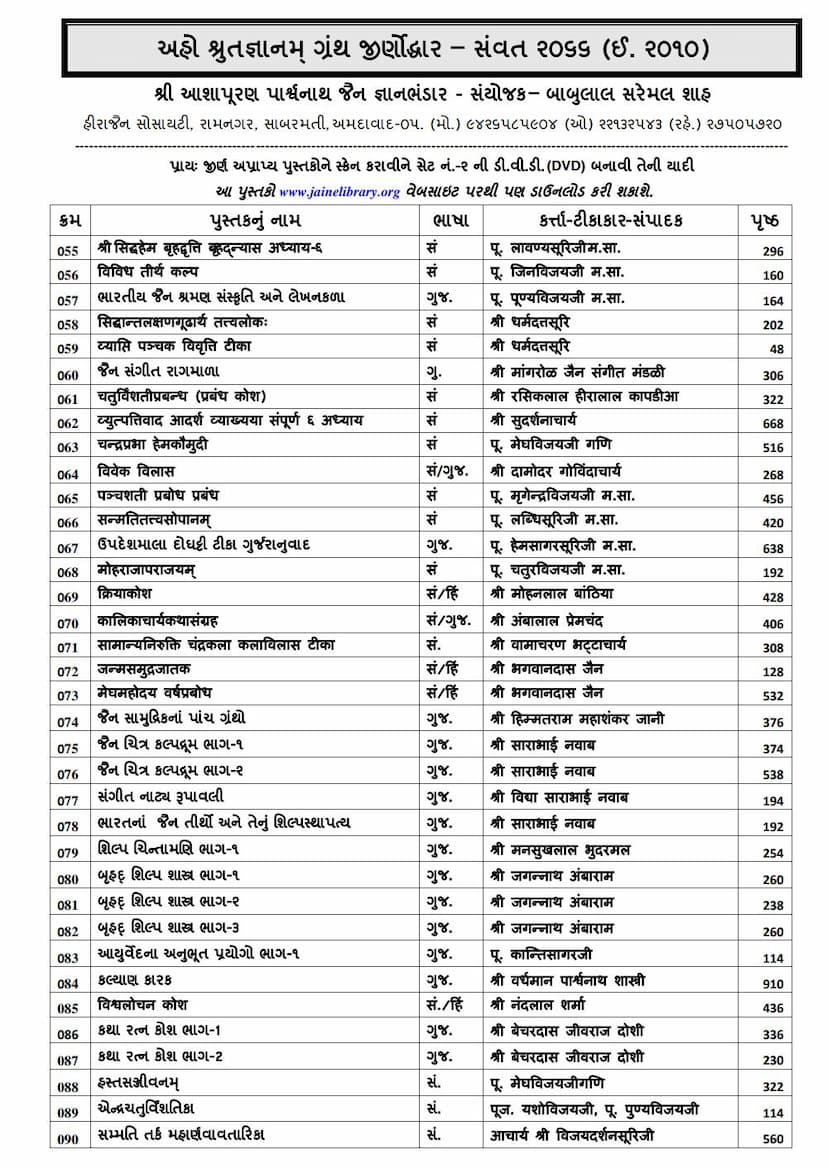Gudhartha Tattvaloka Vyapti Panchak Vrutti
Added to library: September 1, 2025

Summary
This document is an excerpt from a Jain text titled "Gudhartha Tattvaloka Vyapti Panchak Vrutti" by Dharmadattasuri. The provided pages (1-48) and the catalog link suggest that this is a commentary or explanation of a work related to the concept of vyapti (pervasion or invariable concomitance) in Jain logic, likely in the context of anumana (inference).
Here's a breakdown of what can be understood from the provided pages:
General Context:
- Title: "Gudhartha Tattvaloka Vyapti Panchak Vrutti" translates to "Commentary on the Five Aspects of Pervasion, Illuminating the Hidden Meaning of the Truth."
- Author: Dharmadattasuri.
- Publisher/Sponsor: The text is associated with the "Shri Ashapuran Parshwanath Jain Gyanbhandar" (a Jain library) and mentions efforts to preserve and digitize old Jain manuscripts. The project is dated to Samvat 2066 (2010 CE).
- Subject Matter: The core subject is vyapti, a fundamental concept in Indian logic, particularly in the Nyaya and Jain epistemological traditions. Vyapti establishes the invariable relationship between a middle term (hetu) and a major term (sadhya), which is crucial for valid inference. The title indicates a focus on the "five aspects" or "five types" of vyapti, suggesting a classification or detailed analysis of this concept.
- Commentary Style: The text appears to be a detailed philosophical and logical commentary. Pages 5 through 48 consist of what seems to be a shuddhipatra (errata or correction sheet) and extensive philosophical discourse with complex terminology.
Key Observations from the Text (specifically the commentary sections):
- Focus on Inference (Anumana): The commentary delves into the conditions and validity of inference. It discusses the role of pramana (means of valid knowledge) and the examination of the pramanata (validity) of inference.
- Analysis of "Vyapti": A significant portion is dedicated to defining and analyzing the term vyapti. It dissects the meaning of avyabhicaritvam (non-erroneousness or absence of violation) in the context of vyapti.
- Logical Debates and Refutations: The text engages in intricate logical arguments, refuting different viewpoints on vyapti and inference. It uses precise terminology and structured reasoning to establish its points.
- Technical Terminology: The language is highly technical, employing Sanskrit and Prakrit terms common in Indian philosophical and logical discourse. Examples include:
- Hetu (middle term, reason)
- Sadhya (major term, the predicate to be proved)
- Paksha (minor term, the subject of the inference)
- Avyabhicaritvam (invariable concomitance, non-violation)
- Anumana (inference)
- Pramana (means of valid knowledge)
- Sadhana (means, instrument)
- Vyakti (individual instance)
- Vrittitva (ubiquity, pervasiveness)
- Avrittitva (non-ubiquity)
- Samsarga (relation, connection)
- Avachchhinnata (qualification, determination)
- Pratiyogita (negation, counter-subject)
- Adhikaranata (locus, ground)
- Nirupakatva (being the means of defining/determining)
- Errata (Shuddhipatra): Page 5 shows a correction sheet, indicating that the text is being presented in a refined or published form, with specific corrections made to the original manuscript. This is a common practice for scholarly works.
- Detailed Analysis of Concepts: The commentary goes into great detail, often dissecting terms and concepts to their constituent logical elements. For instance, it analyzes the grammatical construction and philosophical implications of terms like sadhya-abhavavada-vrittitva (non-adherence to the seat of the absence of the predicate).
- Exploration of Nuances: The text explores subtle distinctions and potential objections related to the definition and application of vyapti, particularly in cases of avyāpyavritti (partially pervasive) or kevalānvayi (only affirmative) reasoning.
In essence, this text is a scholarly work of Jain philosophy and logic, offering a profound and detailed analysis of the concept of vyapti, which is the bedrock of valid inference in the tradition. It engages in rigorous logical argumentation to define, defend, and apply the principles of vyapti within the framework of Jain epistemology. The preservation and digitization efforts highlighted in the initial pages underscore the importance of such foundational texts in the Jain intellectual heritage.